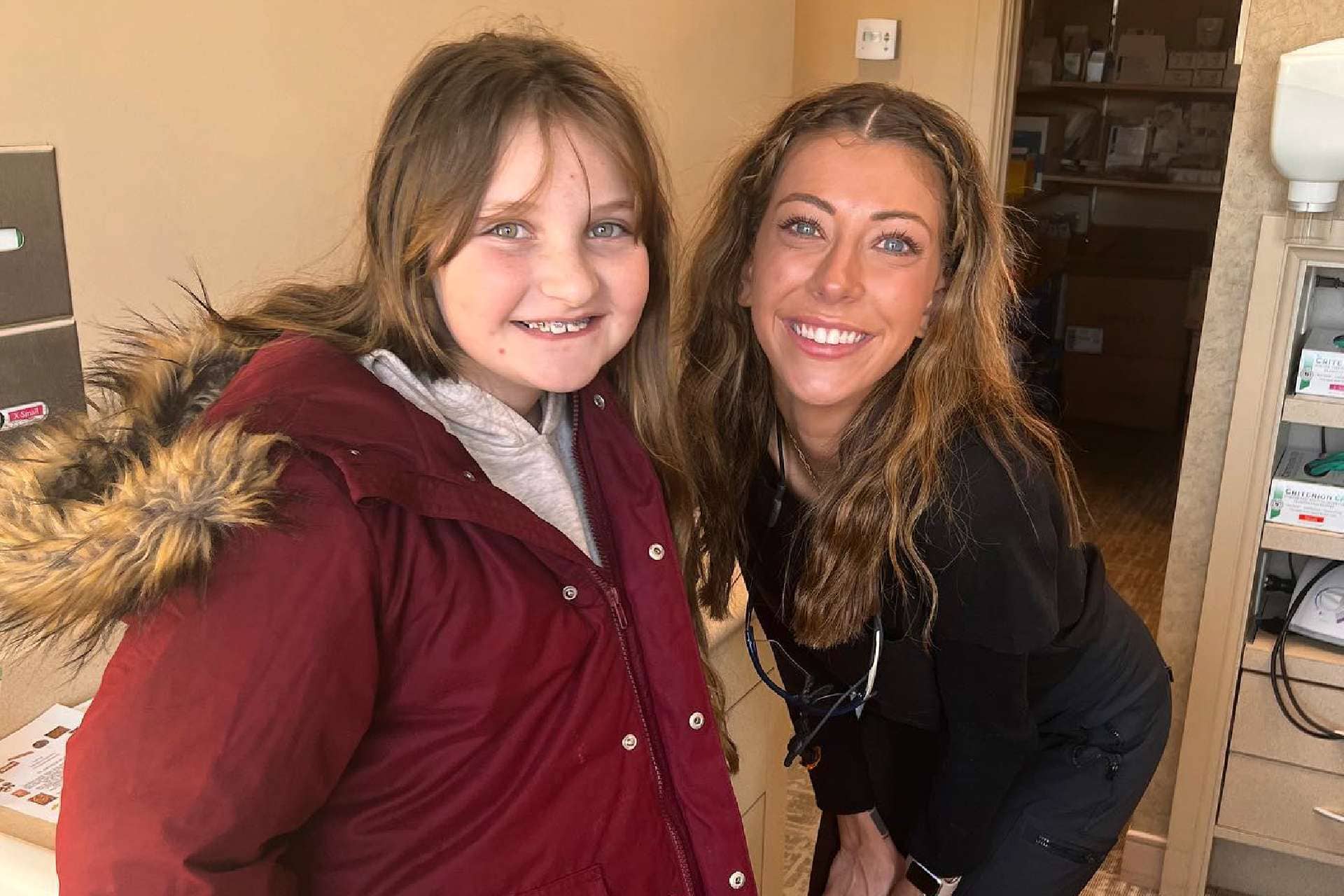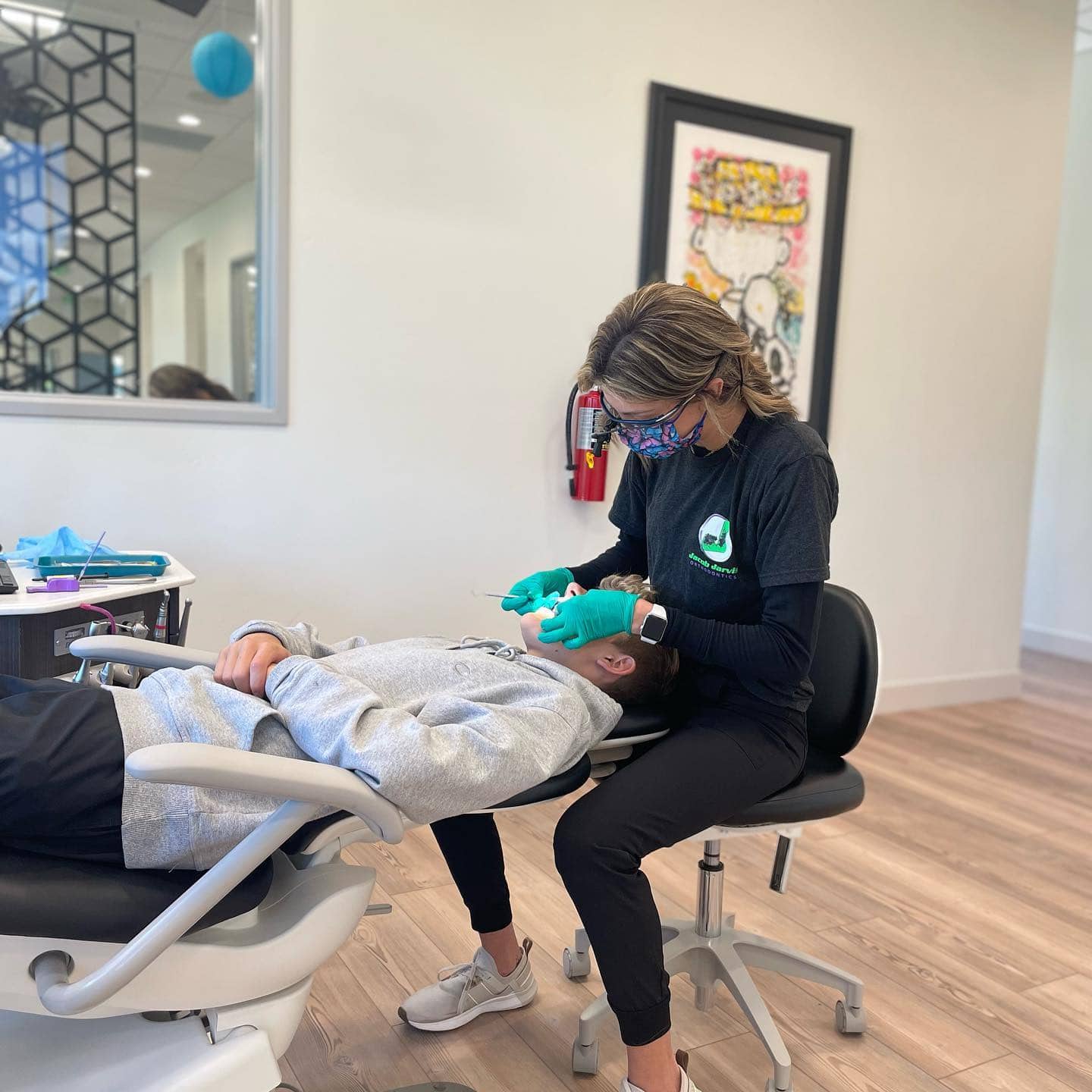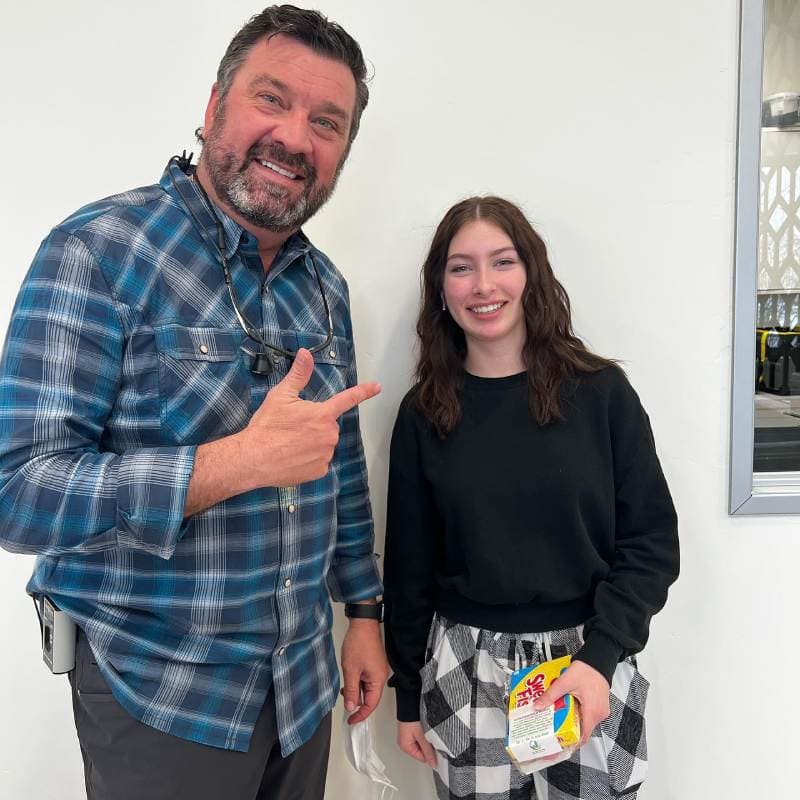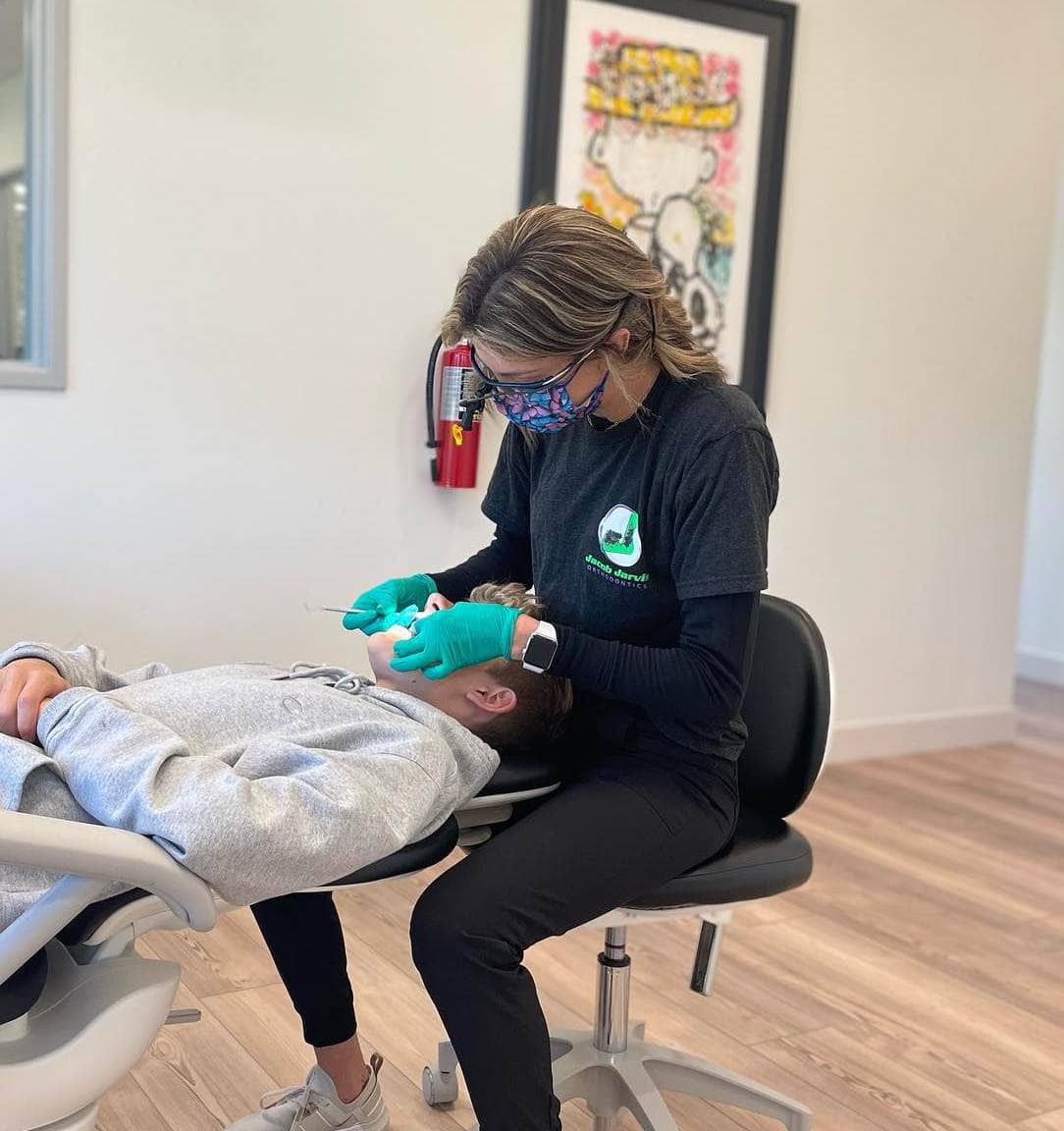Other Treatments
TMJ/TMD Treatment
Pain in the jaw, headaches, and trouble eating and talking are all symptoms of temporomandibular joint dysfunction (TMD), which occurs when the jaw muscles, known as the temporomandibular joint (TMJ), are overworked. This can feel very uncomfortable, and individuals may be unsure of where to go for relief. Fortunately, patients in Boise, ID, can receive treatment from Jacob Jarvis Orthodontics.
What Is TMD?
When you move your jaw, the TMJ, which is where the jaw bone joins to the skull, slides. When this joint is overworked, it causes severe discomfort. TMD discomfort can originate from a variety of sources, including teeth grinding (bruxism), stress, or even trauma to the face, neck, or jaw.
However, it is also believed that genetics, life, and mental pressures, and how someone copes with pain can all play a role in TMD. Additionally, females are more likely to experience this than males.
Jacob Jarvis Orthodontics offers free consultations to patients who are having headaches or jaw discomfort thought to be associated with TMD.
How Do You Recognize TMD/TMJ?
The best way to determine if you have TMD is by consulting with one of our orthodontists for free. It’s possible that your headaches and jaw pain stem from issues unrelated to orthodontics. That is why coming to our office is the best option; either way, we can provide you with an answer. You may check for signs of TMD, such as:
- When you chew, you have pain in your jaw or jaw joint
- The discomfort is spreading to your face and neck
- Your jaw is really tight
- When you open your mouth wide, you hear a popping or clicking sound from your jaw
- Your head pain seems to be coming from the temporal regions.
- You may notice a difference in the way your upper and lower jaws meet
Having one or more of these symptoms may indicate TMD, but they can also suggest other conditions. Contact Jacob Jarvis Orthodontics right away to schedule a free consultation.
TMJ Treatment
If you’re experiencing TMJ issues, the first step toward relief is to make sure your upper and lower jaws are correctly aligned. Using a bite simulator, we can determine if your jaw is properly aligned and discuss the orthodontic alternatives available to you.
In situations when bruxism is the underlying cause of the symptoms, a bite guard may be suggested. By doing so, you can lessen your risk of developing jaw discomfort and headaches, both of which can be exacerbated by teeth grinding.
Talking to Dr. Jarvis is the best approach to figuring out what course of treatment is best for you.
Accelerated Treatment
Accelerated orthodontics is a form of treatment that utilizes advanced technology and innovative techniques to help patients achieve their desired outcomes in a shorter period of time. This orthodontic approach frequently involves the utilization of specialized tools and appliances, such as braces or Invisalign aligners, combined with advanced diagnostic methods and monitoring techniques to optimize potential patient outcomes.
Accelerated orthodontics allows patients to reap the same health and aesthetic advantages of conventional orthodontic treatment in a fraction of the time and with fewer visits to the orthodontist’s office. Additional advantages of accelerated orthodontics include the following:
- Enhanced comfort and flexibility
- Less expensive overall than traditional orthodontic procedures
- Less chance of tooth movement following treatment
Similar to conventional orthodontic treatment, it is imperative to utilize a retainer following the removal of braces to prevent any undesired shifting of the teeth to their original positions.
It is essential to consult with a certified and experienced orthodontist if you are considering accelerated orthodontics for yourself or a family member. Dr. Jarvis will assess your unique requirements and develop a personalized treatment plan to meet those needs. With the assistance of an experienced provider, you can be guaranteed you’ll get the beautiful smile you have always desired in less time.
Propel VPro+
The Propel VPro+ is one of our accelerated treatment options. It uses advanced technology in conjunction with your treatment to speed up orthodontic treatment. It is highly portable and designed with your busy lifestyle in mind.
Individuals use it for just 5 minutes each day, or as otherwise directed by their doctor, to complement their orthodontic treatment. The patient’s own biology is put to use with Propel VPro+, which stimulates the bone around the teeth. Patients will complete their treatment with remarkable outcomes in less time and fewer visits.
Airway Orthodontics
Airway Orthodontics is a specialized field of orthodontics that concentrates on enhancing the wellness and efficiency of the patient’s airway. Airway Orthodontics has the potential to enhance the patient’s respiratory function, minimize snoring and sleep apnea, and enhance overall facial appearance by addressing malocclusions, crowding, and other orthodontic concerns.
Obstructive sleep apnea (OSA) and sleep-disordered breathing (SDB) are both treated with airway orthodontics in Boise, ID. These illnesses typically affect the patient when they are sleeping and make it impossible for them to breathe comfortably or at all while they are sleeping. Typically, specialized appliances, such as jaw repositioning devices, are utilized to treat the condition, which aids in the realignment of both the teeth and jaws.
Enhance Your Sleep Quality With Airway Orthodontics
As previously stated, airway orthodontics is a type of orthodontic therapy designed to address breathing disorders that impact individuals during their sleep. Our team employs airway orthodontics and advanced appliances, including braces and jaw repositioning devices, to facilitate the realignment of teeth and jaws, thereby improving breathing during sleep.
People who suffer from one of these respiratory diseases may wake up several times in the middle of the night, sometimes with no memory of what or why they were awake. Airway orthodontics in Boise, ID, can significantly reduce the patient’s discomfort by improving their breathing and addressing their oral health.
OSA and SDB Treatment
Both OBS and SBD can potentially impact individuals of all ages, including children. It is crucial to remain mindful of the warning signs. The symptoms of sleep apnea can display in the following ways:
- Snoring or gasping for air
- Experiencing difficulties with concentration or memory retention.
- Depression or fatigue
- Dry mouth and a sore throat when you first wake up
- Early-morning headaches
If you notice any of these symptoms, contact Jacob Jarvis Orthodontics to arrange a free consultation with our experienced orthodontist, Dr. Jarvis, to see whether you could benefit from airway orthodontics in Boise, ID.
Two-Phase Treatment
What is the advantage of two-phase orthodontic treatment?
Two-phase orthodontic treatment is a specialized process that combines tooth straightening with physical, and facial changes. The purpose of two-phase treatment is to maximize the opportunity to accomplish the ideal healthy, functional, and aesthetic result that will remain stable throughout your child’s life.
What if treatment is put off?
Putting off treatment can result in a need for more invasive treatment later in life that may not completely fix your child’s smile. Early treatment is most effective for achieving lasting results.
Phase 1
A Foundation for a Lifetime of Beautiful Smiles
The goal of Phase 1 treatment is to help the jaw develop in a way that will accommodate all of the permanent teeth and improve the way the upper and lower jaws fit together. Children often exhibit early signs of jaw problems as they grow and develop. An upper jaw that is growing too much or is too narrow can be recognized at an early age. If children over the age of six are found to have this jaw discrepancy, they are candidates for early orthodontic treatment. Also, if children around the age of eight have crowded front teeth, early treatment can prevent the need to extract permanent teeth later.
Planning now can save your child’s smile later
Children benefit tremendously from early-phase treatment. Receiving early treatment may prevent the removal of permanent teeth later in life, or the need for surgical procedures to realign the jaws.
Resting Phase
In this phase, the remaining permanent teeth are left alone as they erupt. Retaining devices may not be recommended if they would interfere with eruption. It is best to allow the existing permanent teeth some freedom of movement. A successful first phase will have created room for permanent teeth to find an eruption path. Otherwise, they may become impacted or severely displaced.
Monitoring the teeth’s progress
At the end of the first phase of treatment, teeth are not in their final positions. This will be determined and accomplished in the second phase of treatment. Selective removal of certain primary (baby) teeth may be in the best interest of enhancing eruption during this resting phase. Therefore, periodic recall appointments for observation are necessary, usually on a six-month basis.
Phase 2
The goal of the second phase is to make sure each tooth has an exact location in the mouth where it is in harmony with the lips, cheeks, tongue, and other teeth. When this equilibrium is established, the teeth will function together properly. Phase 2 usually involves full upper and lower braces. At the beginning of the first phase, orthodontic records were made and a diagnosis and treatment plan was established. Certain types of appliances were used in the first phase to correct and realign the teeth and jaw.
Retention Phase
This is the final and most important step of your orthodontic treatment. It is a misconception that retainers aren’t forever, but as long as you want to keep everything aligned retainers are lifelong commitments. Our team will make sure you have the knowledge and tools to maintain your smile with check-ups to make sure retainers are fitting properly, this is usually periodic exams throughout the year after your braces are off.
Emergency Care
What to Do in Case of Emergency
Call our office as soon as possible if you break or loosen any of your appliances. Please do not come directly to the office – by calling us, you will allow us to create a time to see you. Even if you have a regular appointment scheduled, call us immediately to notify us if you need an appliance repaired.
Loose Brackets or Bands
Call our office immediately for advice if a bracket or wire is loosened. The bracket may need to be re-fitted as soon as possible. You may have a situation that requires cutting a wire or sliding a bracket off a wire at night or over the weekend. If you need to cut a wire in case of emergency, you may use fingernail clippers that have been washed and sterilized in alcohol. Please call our office the next business day, so that we may schedule an appointment for you.
Wire Irritations
Sometimes discomfort caused by a wire on your braces can be resolved by moving the wire away from the irritated area with a cotton swab or eraser. If the wire will not move, try covering the end of it with a small piece of cotton or a small amount of wax. If the wire is painful, you can cut it with nail clippers or scissors that have been washed and sterilized in alcohol. If you cannot resolve the wire irritation, call our office for an appointment.
Lost Separators
Do not worry about losing a separator, but call our office to see if it needs to be replaced.
Discomfort With Orthodontic Treatment
During the first week after your braces are in place and routine adjustments are complete, you will likely feel some pain, soreness, or discomfort. You may take acetaminophen or other non-aspirin pain relievers while you adjust to your new braces. A warm washcloth or heating pad may reduce the soreness in your jaws.







